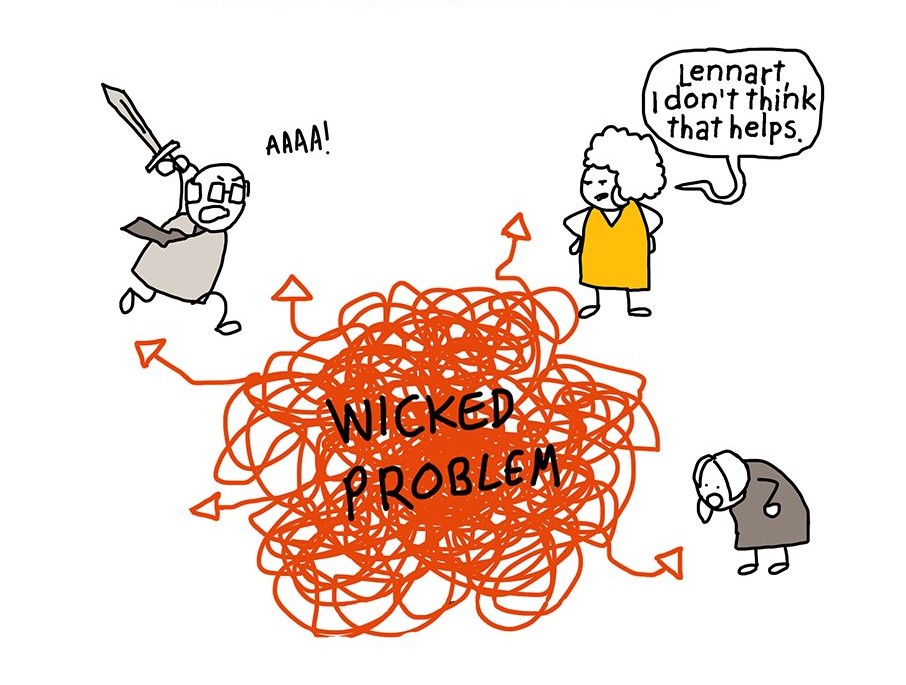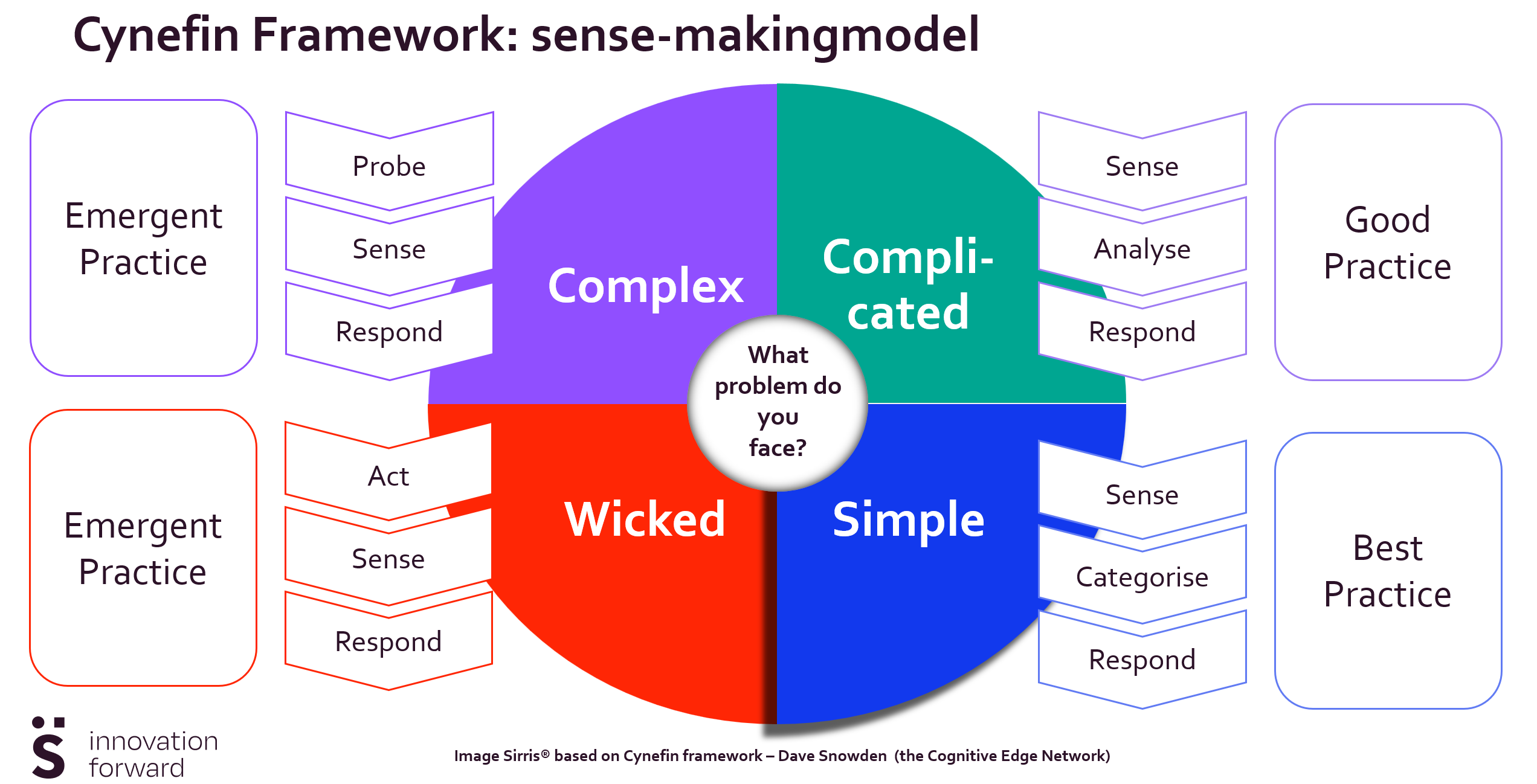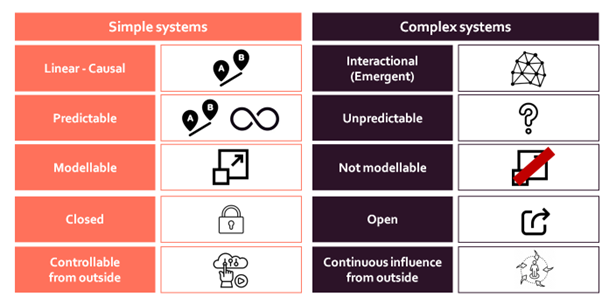More attention on how we act to increase progress towards circularity
Over the years we have been in contact with many people during their circular journeys. While the circular success stories are often shared, we also encountered and witnessed failures and setbacks along the road, even for cases that eventually succeeded. What have we learned so far?
Besides having some luck, we learned that people and their behaviour often make the difference between giving up and perseverance, between rigidity and flexibility, between perception that circularity is impossible and successful implementation of circular practices. We learned that people that adopt a flexible, open and polyvalent approach, consistently make the most progress in their circular journeys.
Why are complex and wicked problems so hard to solve?
In the prevailing business practices, we are biased and trained to analyse and understand problems to be able to predict the outcome of the actions we take (‘think before you act’). Multiple variations on this approach lead to a centralised decision-taking and applying approaches from the past as a blue-print for ‘all’ future challenges. It assumes a single truth based on ‘complete’ knowledge that needs to be transferred to the right level of decision-making in the organisation.
This approach works in situations where cause and effect exist, and can be predicted if you study hard enough or have deep expertise. Projects such as implementing a digital system for condition monitoring, or engineering challenges such as designing a modular design and building a configurator belong to this category. Once you know all ins and outs, you can predict the outcome for each input. This type of challenges can be analysed and fully understood.
The business context is changing. The economy is changing. The strongest long-term economic returns and ditto potential to reduce environmental impact come with a higher complexity. Think of long term contracts with product-as-a-service generating recurring income for a longer period. The transition to a more circular economy confronts us with increasingly complex or chaotic situations. These involve challenges in open systems with many interactions and interdependencies, and with inherently unpredictable outcomes. This type of problems and situations are not or very hard to model effectively.
In some companies that want to extend their business with activities enabling circularity, we see people focusing on the predictable aspects of the challenges for which expertise is required. Of course this gives the subjective feeling that things are under control, and drives them less outside their comfort zone. Obviously, the backside of this behaviour is that other challenges (less predictable and unsolvable with only expertise) are not taken up while they might quickly become the crux for circular progress. It can be seductive to step away from risky projects and choose the comfort zone of certainty.
We learned that entrepreneurial and dynamic circular leaders adopt another way of progressing and learning. An example taken from the - also complex - software development is the scrum/agile approach to take small steps, validate, improve and iterate. This iterative approach is what seems to be a fail-safe approach to make circular progress. To grasp the circular business opportunities, we need to start acting now. It is safe to take small steps and learn by doing.
Another example: mapping the value chain
Mapping the entire value chain with all actors you can think of helps to understand who is involved and how the relations are, but will not help to ‘control’ or ‘steer’ the value chain. We quickly face the limits of our understanding of the challenge, and in the best case, we recognize and identify some unpredictable effects from the behaviour of the actors in the value chain over time. For example, focusing on designing a platform for exchanging data or to match supply and demand of end-of-life goods might be attractive to take up. The real, and more complex, underlying problem might be understanding who has which need and when? Therefore, you need to understand the customer’s or stakeholder’s needs and incentives more in detail. The mapping efforts are very useful to gain insights and see the importance of the underlying relations. The mapping scheme is an incomplete model of the situation that might help to identify the unpredictable effects when changing the interactions and interdependencies.
We describe such effort in our article on how to find partners to build a circular value chain. You can also download a tool that helps you to do this yourself: |
Extending this logic to internal and external actors (people) helps to identify the factors of amplifying as well as resistance. A typical example when starting with product-as-a-service is that the own sales is impacted. Their usual incentives are on regular sales. How can they promote ‘as-a-service’ if it is against their financial benefit? Therefore, new common grounds, including incentives, need to be taken into account.
Release control to assure progress
In our search for success factors the Cynefin framework (by Dave Snowden) describes best what we observe. This sense-making framework helps to define how to approach a problem depending on the problem type. The key is that we have to accept that we don’t always know at the start what type of problem we are facing.
In short, four type of problems are described
- Simple problems: cause and effect relationships exist, are predictable and re repeatable.
- Complicated problems: cause and effect relationships exist, but are not self-evident and therefore require expertise.
- Complex problems: cause and effect are only obvious on hindsight, with unpredictable, emergent outcomes.
- Chaotic (wicked) problems: no cause and effect relationship can be determined.
The simple problems with obvious cause-effect relation have predefined solution methods. Once we know the issues we know how to get to the solution. For this type of problems a best practice is applied.
Example: we need to know the status of an end-of-life product, therefore we need to inspect and test it. There is a best practice to test a device or a component to identify the status.
The complicated problems are the ones we described above as the problems you can analyse to find the solution. Here you need expertise to find the solution so engage an expert and set up a good practice to find the solution. Since situations differ, multiple good practices might be applied with success, depending on the situation. The expert could help to find your good practice.
Example: we need to build the technology for product monitoring; engaging an expert in this domain can be wise. This expert can lead us to the right technology stack, to have this problem solved for your specific product, market,…
More complex problems cannot be resolved by expertise or a good practice since the cause and effect cannot be predicted, but only detected after actions are taken. This is where frontrunning circular economy practitioners ‘release control’ and follow another approach. They do not have a fixed stepping plan defining from start to end goal. They use a set of guidance principles and above all, a dream or energising vision that other people are attracted to.
Example: we are in the process of changing from product sales to product-as-a-service . This might lead to becoming competition of your current customer (e.g., distributors/installers) while you still need them to install and service the products. We will need to start communicating, finding out where mutual benefits are situated,… It will require some small scale experiments, small steps to building common ground.
Elements or approaches that are best adapted to complex environments
- Baby steps, experiments, learning by doing.
- Adopting multiple viewpoints, frequently swapping between the very concrete level and the systemic helicopter view.
- Reflexive monitoring, using your vision and ambition as compass.
- An open mindset towards collaboration with stakeholders inside and outside your organisation.
- Allowing for some chaos & failure and not trying to control the uncontrollable.
- Not presuming that solutions always work the same way in different contexts. For example, don’ t expect that a solution that proved successful in a pilot can be scaled up without adaptation.
When starting to concretise circular strategies, such as repair, refurbish or reuse, the more complex problems are best approached iteratively. Probe or test (small scale experiments, baby steps,…) to learn from and build step by step your emergent practice. Finding out what works and what doesn’t is key. Also discovering the side-conditions for success (e.g., some customer segments are more attracted on refurbished or remanufactured products than other). There is no expert that will be able to provide the solutions. The only way is to test and see if it works.
We expressed this baby steps an iterative approach earlier in articles, such as ‘Don't simply put money into circular projects’, and success cases, such as ‘Modular Lighting Instruments’. |
The chaotic or wicked problems are really unpredictable, because cause and effect cannot be determined. This is a danger zone if entered unintendedly. Prepare yourself and your organisation to deal with this type of problem, which are often crisis type situations. It is about stabilising the situation. You need to act fast, see and evaluate the effect. E.g., sudden supply failures or incidents impacting your brand image need short-term actions from which you will only see the effect later. For innovation purposes, this type of challenges can trigger short-term actions in new, unexplored fields.
Could reflecting questions help to early detect what type of problem you face?
We know for sure that most challenges you face, when trying to make the circular economy real, are not simple and mostly, not complicated but complex. The good news is that you can follow an approach that will eventually lead to progress by focusing on learning and building up emerging practices.
A growing sensitivity to the signals and characteristics of the problem ahead is what we see as a key success element to set up circular projects activities and realise progress . As long as we are used to simple problems, we tend to resolve all upcoming challenges with the tool for simple problems. That is a risk of being ‘unwittingly unaware’. This is why we need to know whether our circular challenge is (not) simple.
In the above scheme we compare simple (and complicated) systems with complex systems. Apparently the clue is to recognize whether the challenge you face shows signs of a complex problem. Reflective questions on those five characteristics can be formulated. Some of the reflective questions we see being used in frontrunning companies are:
- Do you see signs that the effect of a decision is dependent of multiple interactions?
- Can the effect be different with a similar intervention? How predictable is the outcome of an action?
- To what extend are simplified models useful? Can you define the side conditions to which the model is of practical use? Is it hard to define the boundaries of such a simplified model?
- Do you recognize external interactions (outside the team, outside the company or value chain) affecting the system?
- To what extend do you (as a person) affect the system? What is your effective impact of your behaviour (e.g., leading by example), decisions, communication?
How can we support you?
At Sirris, we support people with different roles in companies, to embrace the complexity of the circular economy. We have experienced in our company projects the complexity and the importance of how to approach this type of situations. This why we ask you to give us your feedback on this article. Is the content relevant to you, do the reflective questions help to define your approach? Let us know!
Just like you, we learn from others, such as Dave Snowden, and we strongly advise you to watch the more detailed introduction to the Cynefin framework by the author himself in this 8 minute YouTube video.







